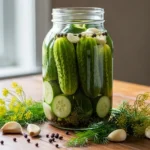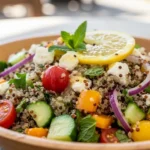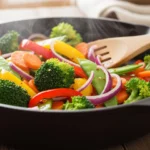Hey! We’re Pedro Recipes (And We’re So Glad You’re Here)
Look, we get it. Fermented foods sound intimidating. Scary, even. When most people hear “fermentation,” they picture science experiments gone wrong, mysterious bubbles, and the potential for food poisoning. We’ve been there. We’ve had the explosions. We’ve created things that smelled… questionable.
But here’s what we’ve learned after thousands of hours in our kitchens, hundreds of batches of sauerkraut that went sideways, and more sourdough failures than we care to admit: fermentation isn’t mystical or dangerous. It’s one of the oldest, safest, most forgiving cooking techniques humans have ever invented. And it creates some of the most delicious, gut-healthy food you’ll ever taste.
Our Purpose
I’ll never forget the moment this whole thing started. It was a Wednesday afternoon in my Portland kitchen, and I was standing over my third failed batch of kimchi that week. My hands smelled like fish sauce, my counter was covered in gochugaru stains, and I was about ready to give up. My wife walked in, took one look at me, and said, “You know what your problem is? You’re treating this like restaurant cooking. Just let it happen.”
She was right. I’d spent twenty years as a professional chef, trained in precision and control, and here I was trying to micromanage millions of bacteria doing what they’d been doing for millennia. That night, I made a batch of sauerkraut without overthinking it. Just cabbage, salt, and patience. And it was perfect.
That’s when it hit me: if a trained chef could get this wrong by overthinking it, imagine how intimidated regular home cooks must feel. The fermentation world was full of either super technical scientific approaches or vague hippie wisdom about “trusting the process.” There was nothing in between. Nothing for the person who just wanted to make really good pickles without a pH meter or a degree in microbiology.
We created Pedro Recipes because you deserve better than scary fermentation gatekeeping. You deserve recipes that actually work, written by people who’ve made every mistake first so you don’t have to. Because here’s the truth: your grandmother probably fermented food without even thinking about it, and you can too.
Our Mission
Every single day, we’re in our kitchens testing recipes. And I mean actually testing them—not just once in perfect conditions, but repeatedly, in different temperatures, with different ingredients, even when we’re tired and just want dinner to work. Because you’re not cooking in a professional kitchen with perfect conditions. You’re cooking in real life.
Pedro develops recipes with one rule: if his neighbor (who’s never fermented anything) can’t succeed with it, it doesn’t go live. James tests every recipe at high altitude because fermentation acts differently in Bainbridge, NY than it does at sea level. William sources ingredients the way you do—from regular grocery stores, not specialty markets. John makes everything work for busy weeknights because who has time for three-day fermentation projects on a Tuesday?
We’ve built this for the 50,000 home cooks who visit us monthly (honestly, that number still blows our minds). We’re not fermentation purists who judge you for using store-bought starter or skipping the fancy salt. We’re your friends who want you to eat really delicious, gut-healthy food without the stress.
Gary photographs everything exactly as it looks in real kitchens—condensation on jars, bubbles that aren’t perfectly symmetrical, the actual color your sauerkraut will be (not some filtered fantasy). And Dale builds our site to work when your hands are covered in brine and you just need to know if that smell is normal.
Our Vision
Picture this: you open your fridge and there’s a jar of your own kimchi sitting there. Not store-bought. Yours. And you made it without fear, without a safety net, because you actually understand what’s happening in that jar. Your kid tries it (miracle of miracles) and asks for more. Your partner stops buying the expensive kombucha at Whole Foods because yours tastes better.
We’re working toward a world where fermentation isn’t this mysterious art practiced by either grandmothers or hipsters in Brooklyn. It’s just… cooking. The kind of cooking that makes your gut happy, your food budget happier, and gives you that quiet satisfaction of creating something alive and delicious.
We want to influence how people learn fermentation—moving away from fear and toward curiosity. We want you to understand that if humans have been doing this successfully for 10,000 years without refrigeration or pH strips, you can absolutely do it with both those advantages. We’re building this together—your questions shape our content, your failures help us clarify our recipes, your successes remind us why this matters.
Our Core Values
Real Results Over Perfect Theory: Look, fermentation science is fascinating, but you don’t need a microbiology degree to make great sauerkraut. We give you what works in actual kitchens, tested by regular people. When the science matters, we’ll explain it. When it doesn’t affect your results, we skip it. (Yes, this drove our food science consultant a little crazy, but our readers love it.)
Honest About Failures: We publish our disasters. Like the time James’s hot sauce ferment exploded all over his kitchen ceiling at 2 AM. Or when Pedro’s sourdough starter died after five years because he forgot to feed it during vacation. Or William’s first batch of miso that grew mysterious fuzzy things. We learn from spectacular failures, and sharing them saves you from the same fate.
Accessible Always: If you need specialty equipment or ingredients that cost more than $10, we’ll tell you exactly why and offer alternatives. Our baseline test kitchen uses what you’d find at a regular grocery store. We’re not precious about it—fermentation worked in clay pots for millennia, so your mason jar is definitely fine.
Safety Without Scaremongering: Yes, we take food safety seriously. But we also trust that you’re a capable adult who can tell if something’s gone wrong. We’ll teach you what normal fermentation looks and smells like, what warning signs actually matter (spoiler: fewer than you think), and when to trust your gut (literally and figuratively).
Community-Tested Everything: Every recipe goes through what we call “the real world gauntlet”—tested by home cooks in different climates, with different skill levels, using different brands of ingredients. If it only works for us, it’s not ready. If it works for a first-timer in Phoenix and a seasoned cook in Maine, then we publish it.
Meet Our Expert Team (The Humans Behind the Screen)
Pedro Brice – Founder & Chef (Plus Sourdough Obsessive)
Recipe Developer | Home Cook Advocate
Portland, Oregon | Age 42
I grew up in a household where the kitchen was always the heart of our home. My grandmother would spend hours preparing meals from scratch, and I’d sit on the counter watching her work magic with basic ingredients. But when I moved out at 22, I realized I had no idea how to recreate those dishes. I’d call her for guidance, but her instructions were always vague—”a little of this, a pinch of that.” I felt completely lost.
That frustration became my mission. I started documenting everything I learned, writing down actual measurements and techniques that worked. What began as personal notes evolved when friends started asking for my recipes. They weren’t trained chefs—they were busy people who wanted to cook good food without intimidation.
I fell into fermentation almost by accident. A chef I worked under in my twenties kept a sourdough starter older than me and made kimchi in five-gallon buckets in the walk-in. He taught me that fermentation wasn’t precious—it was practical, forgiving, and nearly impossible to screw up if you followed basic guidelines. That changed everything.
Now I develop every recipe on this site with one question: would my 22-year-old self, scared and clueless in his first apartment, be able to succeed with this? If not, I keep refining until the answer is yes.
pedro@pedrorecipes.comJames Matos – Chef (And Grandmother’s Legacy Keeper)
Recipe Developer | Home Cook Advocate
Bainbridge, NY | Age 45
I didn’t grow up in a restaurant kitchen or train at some prestigious culinary institute. I grew up in a small town where dinner meant something. It meant my grandmother’s hands working masa, my mom’s Sunday pot roast that filled the house with warmth, and neighbors who’d knock with extra garden tomatoes. Food was our language before I even knew I was learning to speak it.
By my twenties, I was cooking professionally, but something felt off. I was executing someone else’s vision, plating food that looked perfect but didn’t tell a story. The disconnect ate at me. I wanted to create recipes that felt like home—the kind that get passed down, scribbled on index cards, and adjusted to taste. The kind my abuela never wrote down because she just knew.
Fermentation brought me back to my roots. My grandmother had been fermenting for decades—she just called it “putting up vegetables” or “making the peppers last.” She didn’t know the science, but she understood the rhythm, the patience, the trust required. When I finally asked her to teach me, she was 83 and her hands barely worked, but she walked me through it: “You’ll feel when it’s right.”
I test every recipe at 1,700 feet elevation because fermentation behaves differently in the mountains. If it works here, it’ll work almost anywhere. And I make sure every recipe honors the spirit of what my grandmother taught me—that cooking is about feeding the people you love, not impressing them.
james@pedrorecipes.comWilliam Hardin – Head Chef (And Ingredient Obsessive)
Recipe Creator | Coastal Cooking Advocate
Portland, Maine | Age 38
I grew up on the coast of Maine, where food wasn’t just sustenance—it was tied to the rhythms of the ocean. My father was a lobsterman, my mother ran a small seafood shack, and I spent my childhood learning that fresh, simple ingredients prepared well will always beat fancy techniques with mediocre products. I remember standing on docks at dawn, watching boats come in, understanding that cooking starts long before you turn on the stove.
After culinary school in Boston, I spent fifteen years in restaurant kitchens—starting as a line cook and eventually becoming head chef at a fine dining establishment. I loved the intensity, the precision, the artistry. But somewhere along the way, I realized I was creating food that looked beautiful but had lost the soul of what drew me to cooking. I was chasing Michelin stars when what I really wanted was to help people cook the way my parents did—with confidence, simplicity, and deep respect for ingredients.
Fermentation connects me back to that coastal preservation tradition. My mother pickled everything that came through our door—cucumbers, green beans, even fish. Nothing went to waste. That practical preservation is what fermentation actually is—not some trendy wellness thing, but an ancient way to make food last and taste incredible.
I bring restaurant technique to home fermentation, but I strip away the pretense. You don’t need special jars or expensive salt. You need good ingredients, clean hands, and patience. That’s it. That’s what I teach.
william@pedrorecipes.comJohn Pace – Head Chef (And Midwestern Simplicity Champion)
Recipe Developer | Midwestern Food Champion
Hanover, Indiana | Age 33
I didn’t come from a family of cooks. I came from a family of eaters—the kind of Midwestern household where Sunday dinners were sacred, casseroles were a love language, and nobody left the table hungry. My mom worked two jobs, so cooking was about efficiency and making sure five kids were fed, not culinary artistry. But watching her turn a pound of ground beef, a can of soup, and whatever vegetables we had into something that brought us together? That was magic.
I got into cooking almost by accident. At sixteen, I needed a job and the only place hiring was a local diner. I started as a dishwasher and worked my way to the line, learning from a gruff old cook named Ray who taught me that timing, temperature, and giving a damn were more important than expensive ingredients. After high school, instead of college, I went to culinary school in Indianapolis. My family thought I was crazy.
Fermentation appealed to me because it’s honest cooking. You can’t fake it or rush it. Either the chemistry works or it doesn’t. It’s humbling. And it’s economical—which matters when you grew up watching your mom stretch a grocery budget. A $3 head of cabbage becomes $12 worth of sauerkraut. That’s real value.
I make sure every recipe works for busy people. If you can’t fit it into a weeknight or a hectic weekend, I redesign it. Because cooking—even fermentation—should make your life easier, not more complicated.
john@pedrorecipes.comGary Floyd – Visual Content Director (And Imperfection Photographer)
Recipe Photographer | Food Storyteller
Esperance, New York | Age 47
I didn’t start in food photography. For twenty years, I worked as a commercial photographer in Albany, shooting corporate headshots and product catalogs. It paid bills, but somewhere around year fifteen, I realized I was just going through motions. Then my father had a stroke, and I moved back to Esperance to help my mom. Suddenly, I was spending evenings in her kitchen, and she’d ask me to photograph dishes she was making to send to relatives. “Make it look nice,” she’d say, as if her pot roast needed my help.
But something shifted during those sessions. I started really looking at food—the way steam rose from soup, how afternoon light caught glaze on roasted vegetables, the imperfect beauty of a cake that didn’t quite rise evenly but tasted like heaven. I realized I’d spent two decades making things look artificial when what actually moved me was capturing authenticity.
Fermentation is visually honest. You can’t fake those bubbles or that brine cloud or the way vegetables soften and change color. I photograph it exactly as it appears in your kitchen—condensation on the jar, uneven cabbage distribution, the actual (not filtered) color of kimchi. Because if my photos don’t match what you’re seeing, you’ll think you did something wrong. And you probably didn’t.
Every photo I take serves one purpose: helping you feel confident that what you’re making looks right. That’s it. That’s the whole job.
gary@pedrorecipes.comDale Brown – Web Developer (And Usability Obsessive)
Recipe Platform Builder | Digital Experience Designer
Waco, Texas | Age 28
I grew up in a house where the kitchen was always the center of everything. My mom collected recipes obsessively—clipped from magazines, scribbled on index cards, bookmarked on dozens of websites. But she was constantly frustrated. She’d be cooking with her phone propped against the flour canister, the screen would time out, she’d have to unlock it with messy hands, lose her place, and curse. I watched her struggle for years, thinking: why is technology making this harder instead of easier?
I studied computer science at Baylor, spending most of my time building apps that solved problems I actually cared about. While classmates chased crypto startups, I kept coming back to this question: why does every recipe website suck? Why are they buried under pop-ups, life stories you have to scroll through, and interfaces clearly designed by people who’ve never cooked from a phone in a busy kitchen?
So I built ours differently. Our recipe pages stay awake while you’re cooking. Ingredient lists stay visible when you scroll to instructions. You can tap to cross off steps. The search actually works. And fermentation recipes have built-in timers for each stage because nobody remembers to start their kimchi burping schedule without reminders.
My entire job is making sure the technology gets out of your way so you can focus on the actual fermentation. If you’re fighting with the website, I’ve failed. That keeps me up at night in the best possible way.
dale@pedrorecipes.comHow We Actually Do This Work
Here’s what happens behind the scenes: Pedro has an idea for a recipe—let’s say fermented hot sauce. He makes it three times in his Portland kitchen, adjusting ratios and fermentation times. Once he’s happy, he writes it up and sends it to the team.
James makes it at altitude in Bainbridge. William sources ingredients from a regular grocery store in Portland, Maine—nothing fancy, nothing he wouldn’t expect you to find. John tests it on a busy Wednesday night to make sure the timing actually works for real life. Each of them notes what worked, what confused them, what could be clearer.
Gary photographs the entire process—not styled and perfect, but real. You see the actual bubbles, the actual color, what your counter will actually look like. Dale builds the recipe page to work on phones with sticky hands, testing it while actually cooking.
Then we send it to our testing community—home cooks in different climates who’ve volunteered to be our guinea pigs. They make it and report back. Does it work in Phoenix in summer? Does it work in Minnesota in winter? Does it work for someone who’s never fermented anything before?
Only after all of that—after maybe twenty people have successfully made it in different conditions—do we publish. And even then, we update based on your feedback. You find a better way or run into an issue we missed? We revise the recipe. This is collaborative cooking.
Why Trust Us? (Fair Question!)
Between us, we have seventy-plus years of professional cooking experience. Pedro’s been developing recipes for home cooks for fifteen years. James trained in culinary school and has been cooking professionally for over two decades. William spent fifteen years running restaurant kitchens, including two years at a Michelin-rated establishment. John’s culinary degree and restaurant experience means he understands both technique and efficiency.
But here’s what actually matters: we’ve made every fermentation mistake possible. We’ve had jars explode, mold takeovers, batches that smelled like death, and starters that mysteriously died. We’ve killed sourdough starters, over-salted sauerkraut, and created kimchi so spicy it was basically a weapon.
Those failures taught us more than any success ever could. And they made us better teachers. When you email us worried about something, we’ve probably experienced it. We know what normal looks like, what warning signs actually matter, and when you can relax.
Our readers have successfully completed over 150,000 fermentation projects using our recipes. That number feels surreal. But it also means when we tell you something works, it’s not just our opinion—it’s proven in home kitchens across different climates, skill levels, and equipment situations.
Our Community (That’s You!)
You’ve taught us as much as we’ve taught you. When Maria from Denver emailed about her sauerkraut turning pink, we learned about a harmless yeast we’d never encountered. When Tom from Florida couldn’t get his kombucha to ferment in air conditioning, we figured out that some ferments need ambient warmth to thrive. When Sarah from Seattle said our kimchi was too spicy for her kids, we developed a mild version that still had complex flavor.
This isn’t a one-way street. Your questions shape our content calendar. Your failures help us clarify instructions. Your successes—like when Rachel sent us a photo of her first successful sourdough and said she literally cried—remind us why this matters.
You’re not just following recipes. You’re part of a community of people who believe that creating your own fermented foods is worth the effort, the occasional mess, and the learning curve. You’re the reason we do this work.
Our Promise to You
Every recipe we publish has been tested by at least five people in different conditions. We cite our sources when we reference fermentation science. We update recipes when readers find better methods or when we discover improvements. We admit mistakes publicly—if we get something wrong, we fix it and explain what happened.
We don’t accept payment for recipe features. We don’t recommend products unless we actually use them. If we’re partnering with a brand, we disclose it clearly. Our loyalty is to you, not to advertisers.
We respond to every email—it might take a few days during busy periods, but we read every single message. We answer questions thoughtfully, troubleshoot problems genuinely, and celebrate your successes enthusiastically. Because this community thing? It only works if we show up for it.
Let’s Stay Connected (We Actually Read Our Emails)
General Questions & Feedback
Recipe questions, feedback, success stories, or just want to say hi? We read every email and usually respond within 24-48 hours. Seriously, we love hearing from you—even (especially) when you tell us something didn’t work so we can help troubleshoot.
Email: contact@pedrorecipes.com
Phone: +1 (702) 274-3245
Mail: Bluesky Creativity LLC, 2013 W Compass Ln, Anaheim, CA 92801
Technical Support
Having trouble with your account or is the website acting wonky? Our tech wizard Dale personally handles every support email. He’s usually pretty quick (24-48 hours max), and yes, he actually enjoys solving these puzzles. Issues with recipes not saving, timers not working, or photos not uploading—he’s your guy.
Email: support@pedrorecipes.com
Careers
Want to join our beautifully chaotic team? We’re always looking for passionate people who get excited about fermentation. Right now we’re specifically interested in recipe developers with fermentation experience and food photographers who understand that real beats perfect every time. Even if we don’t have current openings, we love hearing from talented folks—send us your info and we’ll keep you in mind.
Email: career@pedrorecipes.com
For Writers
Love writing about fermentation? We’re always scouting for contributors who share our obsession with making fermented foods accessible. We look for writers who blend personal experience with solid research—and who aren’t afraid to share their kitchen disasters along with their successes. We pay for accepted articles and provide editorial support throughout the process. Send your pitch to our writers’ email with 2-3 published samples (blog posts count!). Fair warning: we’re picky about quality, but we’re also incredibly supportive of our contributor family.
Email: writer@pedrorecipes.com
One Last Thing: If you’re reading this far, you’re probably the kind of person who actually cares about the people behind the recipes. That means a lot to us. We’re not a faceless corporation or an algorithm generating content. We’re six people who genuinely love fermentation and genuinely want to help you succeed. So thanks for being here. Thanks for trusting us with your kitchen adventures. And please, please email us your fermentation wins (and losses). They make our day.




